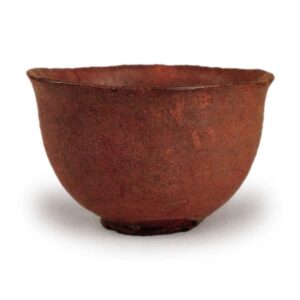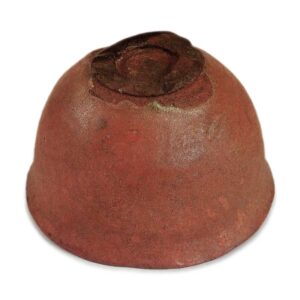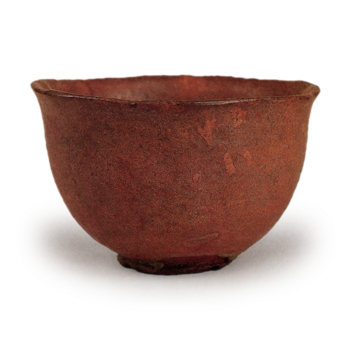

Height 8.9cm, mouth diameter 14.0cm, base diameter 5.4-6.0cm
On the back of the lid of the inner box, Sotan inscribed “Dojoji, Jyakusai (haseki)” and on the back of the lid of the outer box, Kakusai Haraso wrote “Chojiro ware red tea bowl, Sotan inscription, Dojoji, left (haseki), the sound of the bell, Dojoji, this is the name of tea bowl, I hear. Although the origin of this bowl is not known, it was later passed down to the Matsudaira family, lords of Ueda Castle in Shinshu, and became the property of the Kanazawa tea master Kameda Korean after passing from the Matsudaira family to Toda Roucho of Tanimatsuya in 1914, and then to a family in the Kansai region after World War II.
It has an unusual appearance among Chojiro ware tea bowls, and its style is similar to that of Kumagawa, a Korai tea bowl. It is thought that this bowl may have preceded the Soyei-shaped bowls, since it was made by hand and imitated the shape of a tea bowl made by Hazabiki. I once speculated that the “hatano-soritaru chawan” used by Sen no Rikyu at a tea ceremony in Tensho 8 might have been this type of chawan, but of course there are no materials to verify this. However, since the shape of the tea bowl and the construction of the base are very simple, and the taste of the clay and the glaze are similar to the “Shishikawara” (Fig. 90) inscribed in Tensho 2, I estimated that it is an old piece of Chojiro ware, and applied the name “Hatano-soritaru-chawan”. The irregular accumulation of yuzugakari from the outer edge of the bowl to the base of the bowl is a random effect not seen in later red tea bowls, and the base of the bowl is also not formalized at all.
It is needless to say that the inscription by Sotan is based on the image of a tea bowl face down, which is likened to the bell of Dojoji Temple.



